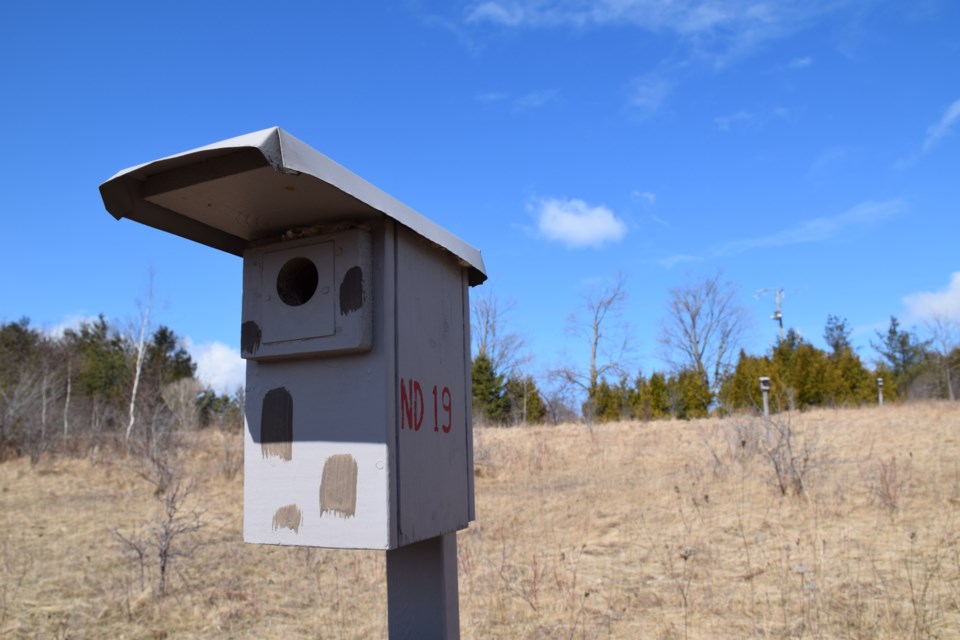The future of an impressive housing project for small birds is uncertain now that the supervisor of the tiny accommodations has left Guelph.
For over 20 years, Joe Kral built, installed, monitored and cleaned small pole-sitting birdhouses intended for bluebirds, but used by a variety of small birds. He recently retired and moved out of the city. The birdhouses Joe built as abundant in and around Guelph Lake Conservation Area.
Back in the early 90s, Joe Kral, described as a master bird box builder, started working to protect the bluebird population. He was expanding on the work started by Nature Guelph to intervene to ensure species like the Eastern Bluebird and Tree Swallow had a place to return to and lay their eggs.
"People told me that they saw bluebirds very rarely in Guelph," said Kral, who moved to Sarnia 15 months ago. "So, I tried to help. I built my first box, and it was very successful. They nested twice. The first was four babies, the second was three babies. It touched my heart."
Like any bird lover, Kral knew that bluebirds can’t burrow their own holes in dead trees, but are squatters that rely on the nesting holes of other species. The need to cut down dead trees to protect people unfortunately cut down on accessible housing in the bluebird home market.
To ensure the birds returned to the Guelph area and flourished here, Kral started building an astonishing number of nesting boxes – small birdhouses that rest on metal poles and are equipped with a hatch for easy cleaning between nesting seasons.
By the time he was done, Kral’s “nest box trail” was made up nearly 1,000 of the boxes. One year he counted 180 baby bluebirds in his nesting boxes.
"I built them all by hand, and every year changed just a little," he said. "I added a metal roof so they would survive many, many years. Each year I got a little smarter."
When he retired from his work as a millwright he moved away from Guelph. Now, there is a gap in what was a highly involved and time-consuming commitment to maintaining the hundreds of bird homes, while monitoring the number of babies each year, and the migratory patterns of the birds.
Greg Meredith, senior resource interpreter with the Guelph Lake Nature Centre, said a number of communities across Ontario have bluebird box programs. The sprawling one that Kral helped establish was primarily in the vicinity of the Guelph Lake, where Meredith and a number of others starting placing boxes many years ago.
“We don’t leave dead standing timber anymore, and we don’t allow beavers to do their thing,” said Meredith, speaking of current regulations in Ontario parks. “So hollow cavities have become fewer and farther between. A bird box emulates an abandoned woodpecker hole in a dead tree.”
While some of the boxes will be monitored by the nature centre, it appears that Kral’s exhaustive efforts will not be duplicated. In his 23 years on the bird-watch, Kral made daily visits to the dwellings, taking daily counts. In total, he counted 32,000 young birds born in the boxes, 2,000 of them bluebirds, and about 30,000 swallows.
Some of his boxes have already begun to come down. Susan Poizner, the Toronto-based author of Growing Urban Orchard’s, and owner of the company Orchard People, arranged to help Kral decommission some of the boxes. She is now selling them for $48 to those who want to keep Kral’s work going on a much smaller scale, while protecting their fruit-bearing trees. Bluebirds feed on insects that can damage those trees. Contact [email protected] to learn more.
Bryan Wyatt, a retired school teacher, worked with Kral for many years, banding birds in order to monitor their migratory patterns. He banded thousands of the little birds over the years.
“Joe came around and lit the flares for the program,” Wyatt said. “He was a person who really believed in what he was doing.”
Meredith described Kral as “an awesome doer,” who relished the opportunity to build more and more boxes.
In the early days of the bird box program, students that visited the nature centre helped monitor about 50 boxes that were on the centre’s property. Kral had a vision for a greatly expanded program, and so he set about expanding it.
“When I started here 28 years ago there were no nesting bluebirds in the park,” Meredith said, adding that 10 new boxes were installed last year, and within two days there was bluebird occupancy. He added there are currently about 17 active bluebird nests in Guelph Lake Conservation Area. The nesting period for bluebirds is from April to July.
“Certainly what Joe did was a real benefit to the birds,” Meredith added. “It gave them options for places to go.” The Tree Swallow is the main user of the boxes, he said, but chickadees, wrens and others use them.
Meredith said the Guelph Lake Nature Centre will expand its cleaning and monitoring of the nest boxes, with the volunteer efforts of school kids. But the extent of that effort has not yet been determined.
Wyatt said the work was a lot of fun, but also a ton of labour, speaking of what he and Kral were able to accomplish. Wyatt monitored about 150 of the boxes last spring, but said it is unlikely that kind of large-scale monitoring will continue. He said anyone taking on the task has to dedicate the entire spring to it. With eight grandchildren, Wyatt said he is unable to continue.
“I suspect there won’t be as much monitoring of the boxes going on,” he said.
